Last Updated on January 26, 2024 by Greg Gillson
A pair of goldfinches in summer can really brighten up your bird feeder!
I can’t believe it’s been over a year since I’ve seen one! Here in San Diego I’m at the southwestern edge of their range. In fact, I only saw one pair of birds in January 2019. I had two sightings in 2017, yet I had a dozen sightings in San Diego in 2018.
I looked at range maps for American Goldfinch online. Boy, are there a bunch of errors concerning the breeding range in the West! I wonder why? Maps in the Sibley and National Geographic guides are accurate.
Many online maps erroneously show birds in winter only in the West. Yet they are common breeding birds in western Oregon, coastal and the Central Valley of California. Many maps only show birds in these locations in the winter or non-breeding season. Here’s an accurate breeding season map from eBird.
This page is an overview of American Goldfinches. I will have links to more in-depth pages to topics including identification, courtship and nesting, range and habitat, and diet and foods you can offer to attract them to your backyard.
 |
|
Male American Goldfinch in breeding plumage
Photo by Greg Gillson
|
American Goldfinch overview
American Goldfinches are tiny birds. Males in breeding plumage are bright lemon yellow with black wings, tail, and forehead. They have sweet lilting calls as the fly over with bounding flight. They have a complicated sweet song in spring.
Happily, they are readily attracted to backyard feeders and bird baths. They eat small seeds, including Niger seed in special “thistle” feeders.
Identification
American Goldfinches measure 4-1/2 to 5 inches in length, from bill tip to tail tip. That’s tiny! They have a wingspan of 7-1/2 to 8-1/2 inches.
These birds are rather stocky. Their head is large and merges into the body in an almost neckless appearance. The long white tail coverts accentuate the short forked tail. The small conical bill is rather thin for a seed eating bird.
Breeding males are bright lemon yellow. The wing and tail feathers are black with white wing edges forming two wide white wing bars. The forehead is black. Both the upper and under tail coverts are white. The legs and feet are brownish pink. The pink bill is short, wide at the base and sharply pointed.
In later in fall the white edges on the wing and tail feathers wear away. Males then appear to have solid dull black wings with only two thin wing bars.
In winter males are pale tan with yellow mostly restricted to the head. The wings are renewed to jet black with many wide white edges to them. The outer edges on the tail feathers are also lined with white.
Females in breeding plumage are duller yellow below with a greenish cast to the back and upper parts. The black wings have narrower white wing bars than the males.
Immatures and winter females are gray-tan with black wings and tail. Immatures in fall show broad tan wing bar. By winter the wing bars are worn thinner and are a dull white color. Thus they match the female in plumage.
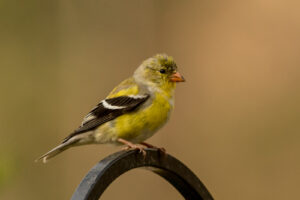
During most of the year American Goldfinches travel in small family groups or flocks. In late fall and early winter flocks of hundreds can form in weedy fields.
Goldfinches feed on the ground or cling to stalks to reach seed heads of grasses and weeds. They hold onto plant stalks acrobatically.
When they fly away, American Goldfinches give a lilting chipping call of about 4 syllables. The call is described as per-chik-o-ree. To many people this sounds more like po-ta-to-chip!
The song is a long complicated lilting trills and chip notes.
The undulating and strongly bounding flight of goldfinches is a quick identification mark when combined with the tiny size and fairly long wings and short tail.
For more in-depth coverage of American Goldfinch identification and how to tell them apart from similar species, please read my article: What do American Goldfinches look like?
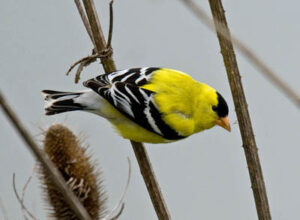
Range and habitat
American Goldfinches breed across the northern two-thirds of the United States and southern Canada. Birds move out of Canada and the northern Great Plains in winter. In winter some birds move to the southern United States and northern and mid-eastern Mexico.
Many birds stay for winter where the weather is mild. Others migrate a short distance southward to find warmer weather.
American Goldfinches are found in weedy open habitats with shrubby trees for nesting. Birds are very common for a few years in regenerating clear cuts. When the trees block out the sun and bushes and weeds no longer grow on the forest floor, goldfinches move out.
These goldfinches are also common in city park and backyard habitats.
For more in-depth information on the range and habitat of American Goldfinches, please read my article: Where do American Goldfinches live?
Diet
American Goldfinches eat almost exclusively seeds. While many seed-eating birds feed their nestlings insects, not so goldfinches.
The favorite seeds that American Goldfinches love to eat are composites, including thistles, sunflowers, and asters. You may see them feeding acrobatically on dandelions in your yard.
They also eat tree seeds from such trees as birch and sweet gum.
At your bird feeder there are two seeds these birds love. American Goldfinches are really attracted to black oil sunflower seeds and Niger seed. They will eat most small seeds from all types of feeders. A “finch feeder” or “thistle sock” with Niger seed attracts goldfinches and siskins almost exclusively, sometimes House Finches.
American Goldfinches are very attracted to water in bird baths, fountains, and drippers.
For more in-depth information on what these goldfinches eat, and feeders to attract them to your yard, please read my article: What do American Goldfinches eat?
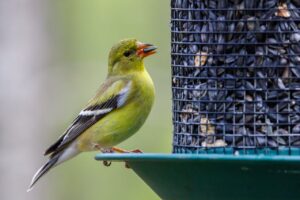
Nesting and reproduction
American Goldfinches are usually monogamous and raise one batch of young each season. Occasionally, however, a female will leave the older nestlings in the care of her mate. She then may seek out another male in which to raise another family of young.
Males start singing in spring. Mating and nesting waits until mid-summer when there are many weed seeds and thistle seeds to feed the young.
The female builds the cup-shaped nest of tightly woven plant fibers. It is bound with spider silk. She lines the nest with the fluff of thistle seeds and similar material.
The female American Goldfinch usually chooses a sapling or other type of small tree or shrub in which to build her nest. The nest is built in the crotch of the branches often under a clump of leaves. The nest height is usually low, from 3 to 10 feet above the ground.
The female lays 2-7 eggs. These are pale bluish, sometimes with spots on the large end. Incubation by the female lasts 12-14 days. Once the eggs hatch the nestlings remain in the nest for another 11-17 days. Nestlings hatch naked and helpless.
For more in-depth information on the courtship and nesting of American Goldfinches, read my article: Where do American Goldfinches like to nest?
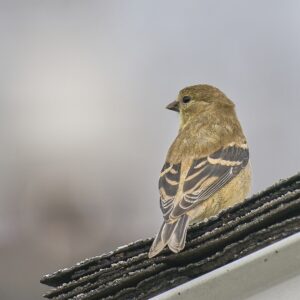
Wrapping Up
The scientific name of the American Goldfinch is Spinus tristis. The word spinus is Greek and refers to a type of bird, but no one today knows exactly which one! The word tristis means sad. Some people think the calls are sad. That is certainly true of the Lesser Goldfinch’s downslurred call. But most of the American Goldfinch’s calls I’d term happy!
Formerly, the scientific genus name was Carduelis. This word means thistle, a favorite food of all goldfinches.
American Goldfinches do not participate in the mobbing of predatory hawks as do many other small birds.
A group of goldfinches is called a “charm.”
Many people call American Goldfinches “wild canaries.” No wonder, they do look much like the common cage bird, the canary. The real canaries are found in the Macaronesian Islands, including the smaller group of Canary Islands off North Africa.
The nest of American Goldfinches is woven so tightly it may hold rain water!
In most of their range American Goldfinches nest very late–July and August. This is so they can feed the seeds of thistles and milkweed to their nestlings.
This is the State Bird of Iowa, New Jersey, and Washington State.
You may see these birds eating upside down at your tube feeder!
American Goldfinches are the only finches to molt body plumage in both spring and fall, changing their appearance in summer and winter.
American Goldfinches have lived in the wild to at least 8 years and 10 months. One bird in captivity lived to be 13 years old.
Frequently Asked Questions
Where are American Goldfinches found?
American Goldfinches are commonly found across most of North America, making them a familiar sight for many birdwatchers. Their range stretches from central Canada in the north, all the way down to central Mexico in the south. During breeding season, their primary habitat includes:
- Open fields and meadows: They favor areas with plenty of weeds, thistles, and other flowering plants, where they can find their main food source of seeds.
- Floodplains and riverbanks: These areas offer similar vegetation that they enjoy.
- Roadsides and cultivated areas: They readily adapt to human-modified landscapes, often utilizing gardens, orchards, and even backyards.
- Open deciduous and riparian woodlands: They may use these areas for nesting and cover, but prefer more open spaces for foraging.
Are American Goldfinches friendly?
American Goldfinches are not considered “friendly” in the strict sense of seeking out human interaction or physical contact. Like many wild birds, they primarily prioritize staying safe and fulfilling their natural needs. However, they can possess certain characteristics that some might consider “friendly”:
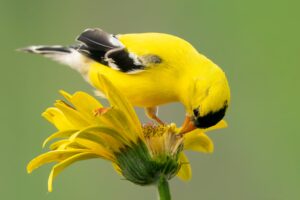
Sociable:
- Unlike solitary birds, American Goldfinches are often found in flocks, even outside the breeding season. This social behavior makes them seem more engaging and interactive compared to birds who usually fly alone.
- They readily visit bird feeders, providing opportunities for observation and enjoyment.
Visually Appealing:
- Their vibrant yellow plumage, especially in males during breeding season, makes them visually captivating and adds a splash of color to their surroundings.
- Their lively movements and cheerful songs can contribute to a sense of peace and connection with nature.
Non-Aggressive:
- They generally pose no threat to humans and are not known for aggressive behavior. Their focus is on finding food and raising young, not interacting with people.
What is an American Goldfinch’s favorite food?
While American Goldfinches might not have a single “favorite” food, they definitely have a strong preference for seeds, particularly those of the composite family, which includes daisies, dandelions, sunflowers, thistles, and asters. Here’s a breakdown of their dietary choices:
Primary Food:
- Seeds: Make up the vast majority of their diet, especially during breeding season when they need protein and fat for their young.
- Specific favorites: Black oil sunflower seeds, thistle (Nyjer) seeds, and seeds from various wildflowers like coneflower, echinacea, and goldenrod are particularly appealing.






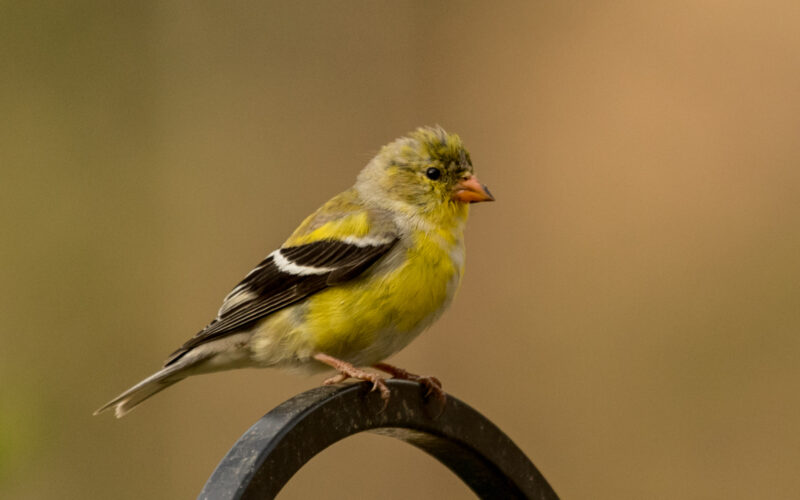
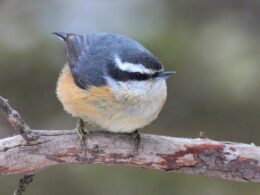
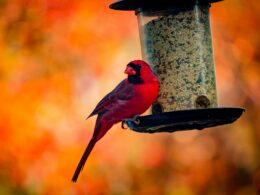
Great article. Thank you!
Thank you for your kind words!